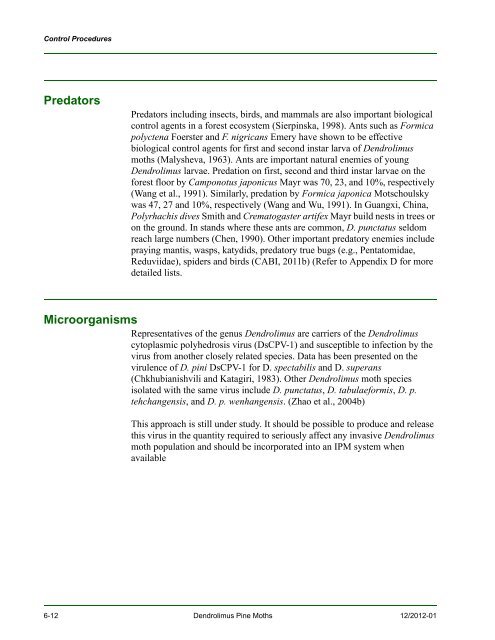New Pest Response Guidelines - aphis - US Department of Agriculture
New Pest Response Guidelines - aphis - US Department of Agriculture
New Pest Response Guidelines - aphis - US Department of Agriculture
You also want an ePaper? Increase the reach of your titles
YUMPU automatically turns print PDFs into web optimized ePapers that Google loves.
Control Procedures<br />
Predators<br />
Predators including insects, birds, and mammals are also important biological<br />
control agents in a forest ecosystem (Sierpinska, 1998). Ants such as Formica<br />
polyctena Foerster and F. nigricans Emery have shown to be effective<br />
biological control agents for first and second instar larva <strong>of</strong> Dendrolimus<br />
moths (Malysheva, 1963). Ants are important natural enemies <strong>of</strong> young<br />
Dendrolimus larvae. Predation on first, second and third instar larvae on the<br />
forest floor by Camponotus japonicus Mayr was 70, 23, and 10%, respectively<br />
(Wang et al., 1991). Similarly, predation by Formica japonica Motschoulsky<br />
was 47, 27 and 10%, respectively (Wang and Wu, 1991). In Guangxi, China,<br />
Polyrhachis dives Smith and Crematogaster artifex Mayr build nests in trees or<br />
on the ground. In stands where these ants are common, D. punctatus seldom<br />
reach large numbers (Chen, 1990). Other important predatory enemies include<br />
praying mantis, wasps, katydids, predatory true bugs (e.g., Pentatomidae,<br />
Reduviidae), spiders and birds (CABI, 2011b) (Refer to Appendix D for more<br />
detailed lists.<br />
Microorganisms<br />
Representatives <strong>of</strong> the genus Dendrolimus are carriers <strong>of</strong> the Dendrolimus<br />
cytoplasmic polyhedrosis virus (DsCPV-1) and susceptible to infection by the<br />
virus from another closely related species. Data has been presented on the<br />
virulence <strong>of</strong> D. pini DsCPV-1 for D. spectabilis and D. superans<br />
(Chkhubianishvili and Katagiri, 1983). Other Dendrolimus moth species<br />
isolated with the same virus include D. punctatus, D. tabulaeformis, D. p.<br />
tehchangensis, and D. p. wenhangensis. (Zhao et al., 2004b)<br />
This approach is still under study. It should be possible to produce and release<br />
this virus in the quantity required to seriously affect any invasive Dendrolimus<br />
moth population and should be incorporated into an IPM system when<br />
available<br />
6-12 Dendrolimus Pine Moths 12/2012-01

















